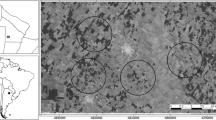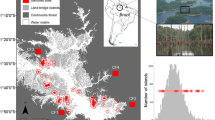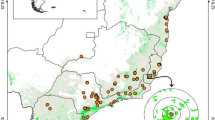Abstract
Recent studies on the effects of tropical forest fragmentation indicate that fragmented landscapes are complex and heterogeneous systems influenced by factors other than the size or degree of isolation of forest remnants: of particular importance are the quality of the matrix and the edge-induced habitat changes. In order to investigate the influence of these factors, small mammals were surveyed in 36 sites in the landscape of Una, a region that encompasses some of the last and largest Atlantic Forest remnants in northeastern Brazil. Six sites were distributed on each of six landscape components – the interiors and edges of small remnants, the interiors and edges of large remnants, and the most common forested habitats found in the matrix. The survey comprised 46,656 trap-nights and yielded 1725 individuals of 20 species of rodents and marsupials. Results revealed: an increase in beta-diversity caused by fragmentation; the contrasting effects of the altered forested habitats of the matrix, which harbor both forest and disturbance-adapted species; a greater importance of edge effect than of patch size to the observed changes in small mammal community in remnants; an association among terrestrial forest species and among arboreal forest species in terms of the distribution and abundance in the Una mosaic; and a distinctive vulnerability of these two groups of species to fragmentation. Results emphasize the biological importance and conservation value of both fragmented landscapes and small remnants in the Atlantic Forest, as well as the importance of management techniques to control and attenuate edge effects.
Similar content being viewed by others
References
Andrén H. 1994. Effects of habitat fragmentation on birds and mammals in landscapes with different proportions of suitable habitat: a review. Oikos 71: 355–364.
Bierregaard Jr. R.O., Laurance W.F., Sites J.W., Lynam A.J., Didham R.K., Andersen M.et al. 1997. Key priorities for the study of fragmented tropical ecosystems. In: Laurance W.F. and Bierregaard R.O. (eds) Tropical Forest Remnants: Ecology, Management, and Conservation of Fragmented Communities. The University of Chicago Press, Chicago, Illinois, pp. 515–525.
Bierregaard Jr. R.O., Gascon C., Lovejoy T.E. and dos Santos A. 2001. Lessons from Amazonia: The Ecology and Conservation of a Fragmented Forest. Yale University Press, New Haven, Connecticut.
Bowers M.A. and Matter S.F. 1997. Landscape ecology of mammals: relationships between density and patch size. Journal of Mammalogy 78: 999–1013.
Chiarello A.G. 1999. Effects of fragmentation of the Atlantic forest on mammal communities in south-eastern Brazil. Biological Conservation 89: 71–82.
Colwell R.K. 1997. EstimateS 5.0.1.–Statistical Estimation of Species Richness and Shared Species from Samples. http: //viceroy.eeb.uconn.edu/estimates
Conservation International do Brasil, Fundação SOS Mata Atlântica, Fundação Biodiversitas, Instituto de Pesquisas Ecológicas, Secretaria do Meio Ambiente do Estado de São Paulo and SEMAD–Instituto Estadual de Florestas–MG 2000. AvaliaçãoeAções Prioritárias para a Conservação da Biodiversidade da Mata Atlântica e Campos Sulinos. MMA/SBF, Brasília, Brazil.
Crome F.H.J. 1997. Researching tropical forest fragmentation: shall we keep on doing what we're doing? In: Laurance W.F. and Bierregaard R.O. (eds) Tropical Forest Remnants: Ecology, Management, and Conservation of Fragmented Communities. The University of Chicago Press, Chicago, Illinois, pp. 485–501.
Davies K.F., Gascon C. and Margules C.R. 2001. Habitat fragmentation: consequences, management and future research priorities. In: Soulé M.E. and Orians G.H. (eds) Conservation Biology: Research Priorities for the Next Decade. Island Press, Washington, DC, pp. 81–97.
Didham R.K., Hammond P.M., Lawton J.H., Eggleton P. and Stork N.E. 1998. Beetle species response to tropical forest fragmentation. Ecological Monographs 68: 295–323.
Didham R.K. and Lawton J.H. 1999. Edge structure determines the magnitude of changes in microclimate and vegetation structure in tropical fragments. Biotropica 31: 17–30.
Dunning J.B., Danielson B.J. and Pulliam H.R. 1992. Ecological processes that affect populations incomplex landscapes. Oikos 65: 169–175.
Fahrig L. 1998. When does fragmentation of breeding habitat a ffect population survival? Ecological Modelling 105: 273–292.
Fahrig L. 2001. How much habitat is enough? Biological Conservation 100: 65–74.
Fonseca G.A.B. and Robinson J.G. 1990. Forest size and structure: competitive and predatory effects on small mammal communities. Biological Conservation 53: 265–294.
Forman R.T.T. and Gordon M. 1986. Landscape Ecology. Wiley and Sons, New York.
Gascon C., Lovejoy T.E., Bierregaard R.O., Malcolm J.R., Stouffer P.C., Vasconcelos H.L.et al. 1999. Matrix habitat and species richness in tropical forest remnants. Biological Conservation 91: 223–229.
Goodman S.M. and Rakotondravony D. 2000. The effects of forest fragmentation and isolation on insectivorous small mammals (Lipotyphla)on Central High Plateau of Madagascar. Journal of Zoology, London 250: 193–200.
Gouvêa J.B.S. 1969. Contribuiçãoàgeomorfologia do Sul da Bahia. Àrea dos baixos cursos dos rios Pardo e Jequitinhonha. CEPEC/CEPLAC ComunicaçãoTécnica 35: 1–11.
Grajon L., Cosson J.F., Judas J. and Ringuet S. 1996. Influence of tropical rainforest fragmentation on mammal communities in French Guiana: short-term effects. Acta Oecologica 17: 673–684.
Kirkland Jr. G.L. 1990. Patterns of initial small mammal community change after clearcutting of temperate North Americanforests. Oikos 59: 313–320.
Kovach Computing Service 1999. MVSP version 3.11b.
Laurance W.F. 1991. Ecological correlates of extinction proneness in Australian tropical rain forest mammals. Conservation Biology 5: 79–89.
Laurance W.F. 1994. Rainforest fragmentation and the structure of small mammal communities in tropical Queensland. Biological Conservation 69: 23–32.
Laurance W.F. and Bierregaard R.O. 1997. Tropical Forest Remnants: Ecology, Management, and Conservation of Fragmented Communities. The University of Chicago Press, Chicago, Illinois.
Laurance W.F., Bierregaard R.O., Gascon C., Didham R.K., Smith A.P., Lynam A.J.et al. 1997. Tropical forest fragmentation: synthesis of a diverse and dynamic discipline. In: Laurance W.F. and Bierregaard R.O. (eds), Tropical Forest Remnants: Ecology, Management, and Conservation of Fragmented Communities. The University of Chicago Press, Chicago, Illinois, pp. 502–514.
Legendre P. and Legendre L. 1998. Numerical Ecology. Elsevier Science, Amsterdam, The Netherlands.
Lomolino M.V. and Perault D.R. 2000. Assembly and disassembly of mammal communities in a fragmented temperate rain forest. Ecology 81: 1517–1532.
Lynam A.J. 1997. Rapid decline of small mammal diversity in monsoon evergreen forest fragments in Thailand. In: Laurance W.F. and Bierregaard R.O. (eds) Tropical Forest Remnants: Ecology, Management, and Conservation of Fragmented Communities. The University of Chicago Press, Chicago, Illinois, pp. 222–240.
Malcolm J.R. 1991. The small mammals of Amazon forest fragments: pattern and process. Ph.D. Dissertation, University of Florida, Gainesville, Florida.
Malcolm J.R. 1994. Edge effects in central Amazonian forest fragments. Ecology 75: 2438–2445.
Malcolm J.R. 1995. Forest structure and the abundance and diversity of Neotropical small mammals. In: Lowman M.D. and Nadkarni N.M. (eds) Forest Canopies. Academic Press, SanDiego, California, pp. 179–197.
Malcolm J.R. 2001. Extending models of edge effects to diverse landscape con gurations. In: Bierregaard Jr. R.O., Gascon C., Lovejoy T.E. and Mesquita R. (eds) Lessons from Amazonia: The Ecology and Conservation of a Fragmented Forest. Yale University Press, New Haven, Connecticut, pp. 346–357.
Medellin R.A. and Equihua M. 1998. Mammal species richness and habitat use in rainforest and abandoned agricultural elds in Chiapas, Mexico. Journal of Applied Ecology 35: 13–23.
Mesquita R.C.G., Delamonica P. and Laurance W.F. 1999. Effects of matrix type on edge related tree mortality in Amazonian forest fragments. Biological Conservation 91: 129–134.
Metzger J.P. 1999. Estrutura da paisagem e fragmentação: análise bibliográca. Anais da Acadêmia Brasileira de Ciências 71: 445–463.
Metzger J.P. 2000. Tree functional group richness and landscape structure in a Brazilian tropical fragmented landscape. Ecological Applications 10: 1147–1161.
Montgomery D.C. 2001. Design and Analysis of Experiments. John Wiley, New York.
Moura R.T. 1999. Análise comparativa da estrutura da comunidade de pequenos mamíferos em remanescentes de Mata Atlantica e plantio de cacau em sistema de cabruca no Sul da Bahia. Master Thesis, Universidade Federal de Minas Gerais, Belo Horizonte, Brazil.
Nupp T.E. and Swihart R.K. 2000. Landscape-level correlates of small-mammal assemblages in forest fragments of farmland. Journal of Mammalogy 81: 512–526.
Ortiz J.V., Faria D., Baumgarten J. and Pardini R. 2002. Faunal responses to different habitats and landscape con gurations in Southeastern Bahia: implications for ecological corridors planning. In: Milano M.S. (ed) III Congresso Brasileiro de Unidades de Consevação–Anais. Rede Nacional de Unidades de Conservação, Fundação O Boticário de ProteçãoàNatureza, Associação Caatinga, Fortaleza, Brazil, pp. 629–638.
Paglia A.P., De Marco Jr. P., Costa F.M., Pereira R.F. and Lessa G. 1995. Heterogeneidade estrutural e diversidade de pequenos mamíferos em um fragmento de mata secundária de Minas Gerais, Brasil. Revista Brasileira de Zoologia 12: 67–79.
Pardini R. 2001. Pequenos mamíferos e a fragmentação da Mata Atlântica de Una, Sul da Bahia–Processos e Conservação. Ph.D.Dissertation, Departamento de Zoologia, Instituto de Biociências, Universidade de São Paulo, São Paulo, Brazil.
Pardini R., Faria D. and Baumgarten J. 2000. Biological guidelines to conservation plans: the RestaUna Project and the Una Biological Reserve, South Bahia. In: Milano M.S. and Theulen V. (eds) II Congresso Brasileiro de Unidades de Conservação–Anais–Volume II–Trabalhos Técnicos. Rede Nacional Pro ´Unidades de Conservação, Campo Grande, Brazil, pp. 715–721.
Parsons J.J. 1972. Spread of African pasture grasses to the American tropics. Journal of Range Management 25: 12–24.
Pires A.S., Lira P.K., Fernandez F.A.S., Schittini G.M. and Oliveira L.C. 2002. Frequency of movements of small mammals among Atlantic Coastal Forest fragments in Brazil. Biological Conservation 108: 229–237.
Renjifo L.M. 2001. Effect of natural and anthropogenic landscape matrices on the abundance of subandean bird species. Ecological Applications 11: 14–31.
Stallings J.R. 1989. Small mammal inventories in an eastern Brazilian park. Bulletin Florida State Museum, Biological Sciences 34: 153–200.
Stevens S.M. and Husband T.P. 1998. The influence of edge on small mammals: evidence from Brazilian Atlantic Forest fragments. Biological Conservation 85: 1–8.
Summerville K.S. and Crist T.O. 2001. Effects of experimental habitat fragmentation on patch use by butterflies and skippers (Lepidoptera). Ecology 82: 1360–1370.
Systat, Inc. 1993. SYSTAT 5.03 for Windows. Systat Software, Inc., Richmond, California.
Taylor P.D., Fahrig L., Henein K. and Merrian G. 1993. Connectivity is a vital element of landscape structure. Oikos 68: 571–573.
ter Braak C.J.F. and Smilauer P. 1998. CANOCO for Windows version 4.0. Center for Biometry Wageningen CPRO-DLO, Wageningen, The Netherlands.
Thomas W.M.W., Carvalho A.M.V., Amorim A.M.A., Garrison J. and Arbeláez A.L. 1998. Plant endemism in two forests in southern Bahia, Brazil. Biodiversity and Conservation 7: 311–322.
Vieira E.M. 1999. Estudo comparativo de comunidades de pequenos mamíferos em duas áreas de Mata Atlântica situadas a diferentes altitudes no sudeste do Brasil. Ph.D.Dissertation, Universidade Estadual de Campinas, Campinas, Brazil.
Villard M., Trzcinski M.K. and Merrian G. 1999. Fragmentation effects on forest birds: relative influence of woodland cover and con guration on landscape occupancy. Conservation Biology 13: 774–783.
Author information
Authors and Affiliations
Rights and permissions
About this article
Cite this article
Pardini, R. Effects of forest fragmentation on small mammals in an Atlantic Forest landscape. Biodiversity and Conservation 13, 2567–2586 (2004). https://doi.org/10.1023/B:BIOC.0000048452.18878.2d
Issue Date:
DOI: https://doi.org/10.1023/B:BIOC.0000048452.18878.2d




